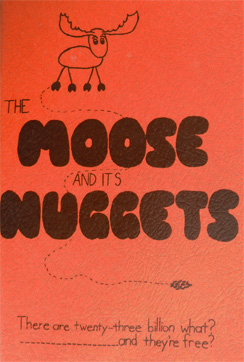Nature up close: Moose
By contributing "Sunday Morning" nature videographer Judy Lehmberg:
Moose are the largest member of the deer family. They live in colder climates in North America as well as in Siberia and northern Europe. They are extremely well-adapted to cold, but do poorly in warm climates due to a lack of sweat glands and a large volume-to-surface area ratio. If you haven't thought about it before, it may take a minute to appreciate the importance of that ratio.
Small animals have a lot of skin in comparison to the volume of internal tissues. That is, they have a high surface area-to-volume ratio. Therefore, they loose heat rapidly, and do well in warm climates. Large animals have less skin -- less surface area -- in comparison to the volume of their internal tissues, so they have a high volume-to-surface area ratio. They are just the opposite of small animals in their ability to retain heat; they do well in cold climates because they can retain their body heat much better than a small animal can.
As climate change warms their environment, most animals that are well-adapted to cold climates -- that have a high volume-to-surface area ratio -- cannot change. That may be one of the reasons moose populations have been declining all over their range since 1990.
- Minn. moose population mysteriously dwindling ("CBS Evening News," 02/18/14)
- Moose dodges traffic on icy Russian highway (CBS News video)
Moose are mostly browsers, eating willows, aspen, red-osier dogwood, red maple, and aquatic plants (sometimes called moose muck). Therefore a good place to look for moose is in northern areas with water supporting aquatic vegetation.
All of those basic biology facts are great, but to me the neatest thing about a moose is its scat. Yes, I'm talking about moose droppings.
Sometime in the early 1970s I got a little booklet entitled "The Moose and Its Nuggets." It took me a minute to realize the author was talking about moose droppings. I don't remember the whole booklet but I definitely remember the most important part: how to make a necklace from moose scat.
Moose scat comes in two shapes: the cow patty shape when they are eating lots of wet food, especially in the spring and summer, and the nice one-inch long oval-shaped "nuggets" they produce in the fall and winter during the drier months. The dry oval-shaped droppings have no odor and are very consistent in their shape and size. Put a couple of layers of varnish on them and run a needle through them lengthwise and voila, you have a bead. String that bead along with some others interspaced with small wooden beads on a thin piece of twine and you have a necklace. (Kind of hippy-looking, but like I said it was the early '70s.) I made several necklaces, gave some to my friends and proudly wore one myself. To this day I still have that necklace, although my husband won't be seen with me when I wear it. I also have a T-shirt a long-time friend gave me with a cute drawing of a moose and a statement about its droppings I can't repeat here.
Speaking of cute -- somehow moose are at the same time majestic and rather doofus-looking. The sheer size and huge palmate antlers of a large male moose (over six feet tall at the shoulder) give it a regal appearance.
But when you look more closely, just as one is pulling his snout out of the water, they just look doofus. That long, big overhanging face makes a moose both unmistakable and goofy-looking.
Whatever aspect of moose you are interested in, you can't deny they are really cute in their own way, and we are all lucky if we see one.
Judy Lehmberg is a former college biology teacher who now shoots nature videos.
For more info:
- Judy Lehmberg (Official site)
- Judy Lehmberg's YouTube Channel
To watch extended "Sunday Morning" Nature videos click here!
